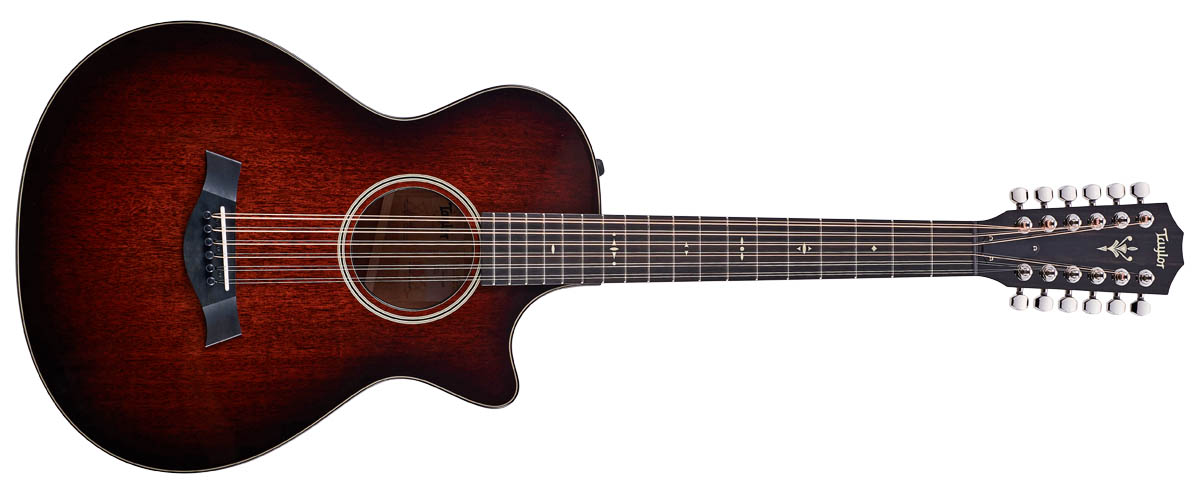Guitar World Verdict
A top-quality 12-string with an immaculate, inventive build and awesome tone, but all this comes at a price.
Pros
- +
Sharply built and compact.
- +
Great clarity,sustain and tuning stability.
Cons
- -
The price point might put off some casual would-be 12-string players.
You can trust Guitar World
Building an acoustic guitar isn’t exactly rocket science, or is it? Spend a few minutes talking to Andy Powers, Taylor’s chief designer and father of the company’s V-Class bracing system, and you might begin to think otherwise.
Tuning a 12-string guitar is, for many, an onerous task, and the end result is often a compromise, but Taylor might just be offering frustrated 12-string veterans a little light at the end of the tunnel with its new 562ce.
It’s the first 12-string in the catalogue that includes the V-Class bracing system, but the refinements haven’t stopped there. Andy has thought the entire process through and made a few design tweaks here and there that could usher in a brave new world of tuneful 12-string sonority. The eagle-eyed might have noticed the first of those adjustments in the accompanying photograph: a 12-string with only six string pegs? What the heck is going on?
Before we address the thinking behind the new addition to the Taylor range, let’s look at the basics. To begin with, the 562ce is a compact 12-frets-to-the-body with mahogany back, sides, top and neck, an ebony ’board and Taylor’s proven Expression System 2 pickup.
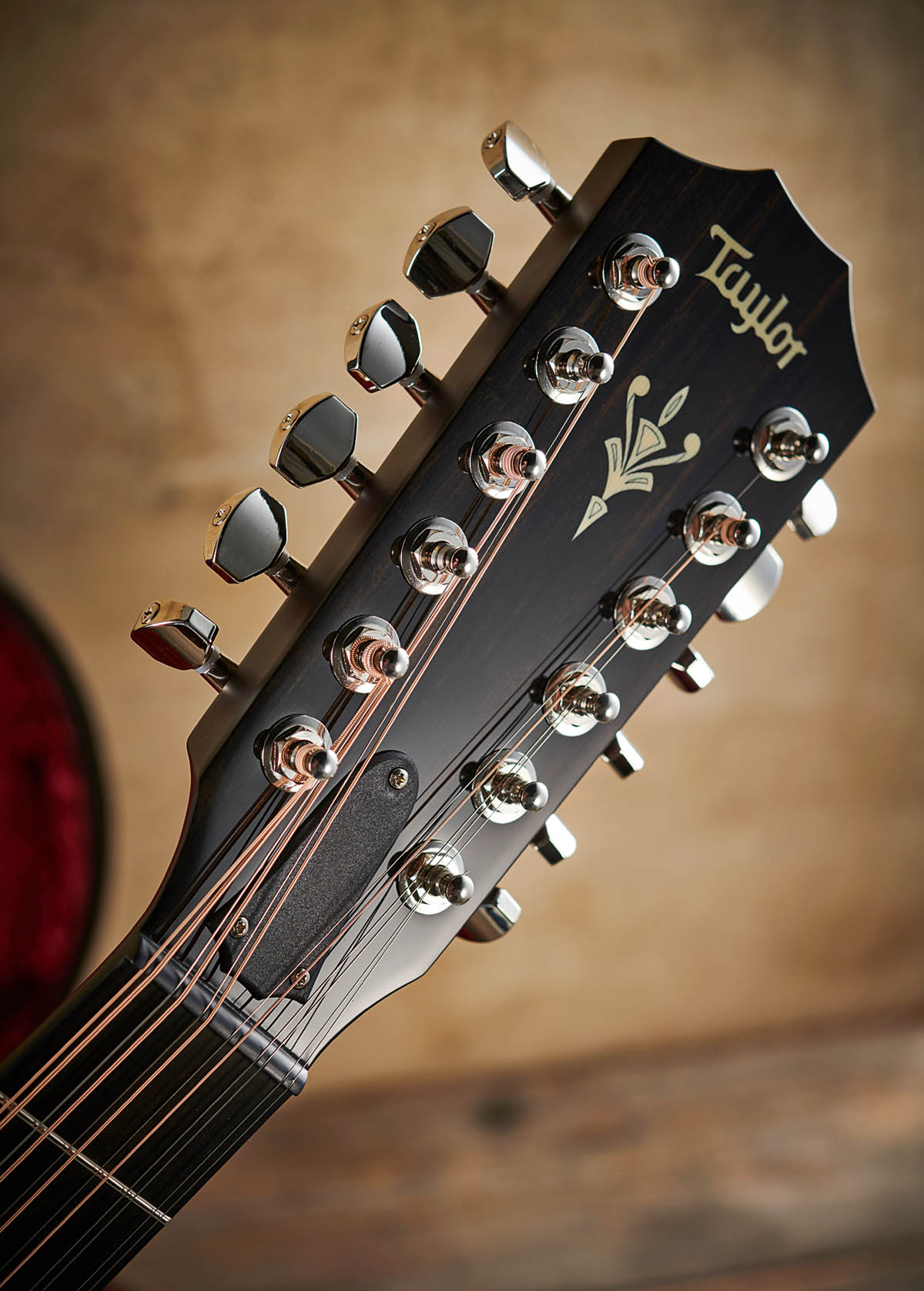
It’s a smaller body Grand Concert design that is decidedly lap-friendly and the fact that the neck joins the body at the 12th fret nicely underlines the compact nature of the instrument. No fat unwieldy jumbo-sized offerings in this vicinity. In fact, the body measures just 495mm (19.5 inches) in length and, at only 381mm (15 inches) across and 111mm (4.375 inches) deep, the 562ce is positively cuddly.
The décor is relatively sombre, too, with what Taylor refers to as a “medium brown stain with shaded edge burst” in high gloss with mock tortoiseshell bindings and a rosette combining more tortoise with grained ivoroid. Overall, it’s an attractive, understated look.
If you’re not already familiar with Taylor’s V-Class bracing system then in brief it means that the soundboard support comprises two main braces that run almost the complete length of the body in an inverted V shape. The reasoning here is that this method of bracing ensures increased volume, sustain and tuning stability.
This way around, Andy Powers insists, the instrument is more in tune with itself. Other acoustics from the Taylor range with the V-Class system onboard have met with favourable reviews in this very tome and so, as far as we’re concerned, Mr Powers is certainly on to something with his new bracing initiative.
When we do, we’re met with a fresh, shimmery response. There’s certainly definition in the treble and not a trace of boominess in the bass
All well and good, of course, but a 12-string is a slightly different kettle of fish that brings with it some new challenges. Where exactly do you start ironing out the wrinkles hereabouts? As far as the tuning problems are concerned, Andy has a theory.
“You’re taking a string and adding another next to it that has the same musical note but is expected to double up a perfect octave overtone of the first note,” he explains. “That’s tricky because you want a mathematically perfect octave harmonic of this lower fundamental note, but since it is a second independent string, it will generate its own harmonic series.
"As an example, if I play the open G, and I play the octave open G next to it, even though they’re trying to vibrate at the same musical note an octave apart, the octave harmonic of the lower string will interact with the open high string if they’re not spot on. The flatter note will get shoved further flat and the sharper one further sharp.”
The same goes for the treble B and E unison strings where the two strings will try to fight each other as they try to occupy the same sonic space, resulting in them sounding out of tune, no matter how hard you, the player, try to remedy the problem.
To add to the 12-string’s woes, there’s the question of stability in the woods. With roughly 108kg (240lb) exerted by a set of light-gauge 12-strings, the temptation is to build more rigidity into the design. But the secondary strings on a 12-string are very light and so how do you transfer their vibration to the body successfully if they’re fighting against a tougher build?
To begin with, Andy decided the more compact Grand Concert body shape was a good host and that the 12-fret neck meant the bridge could sit further back on the guitar’s body for increased resonance, as it’s located on a wider part of the guitar’s top. The smaller body size also helps the general sound of the guitar with a natural shift in emphasis to the treble side of the frequency spectrum.
The bridge was another masterstroke. The string pairs sharing a string peg each meant the bridge didn’t need to be bulky and could also be made to be lighter. In addition, the break angle across the string saddle is consistent with each string pair.
“The string angle over the saddle affects the way each string of a pair interacts with the top,” says Andy. “A more consistent downward pressure against the saddle helps them behave in a more uniform way and benefits both the tuning and response of the string pair.”
You have to admit that the brains at Taylor have done their homework here, but the most important thing is how all this careful scientific thinking has affected the tone and playability of the 562ce.
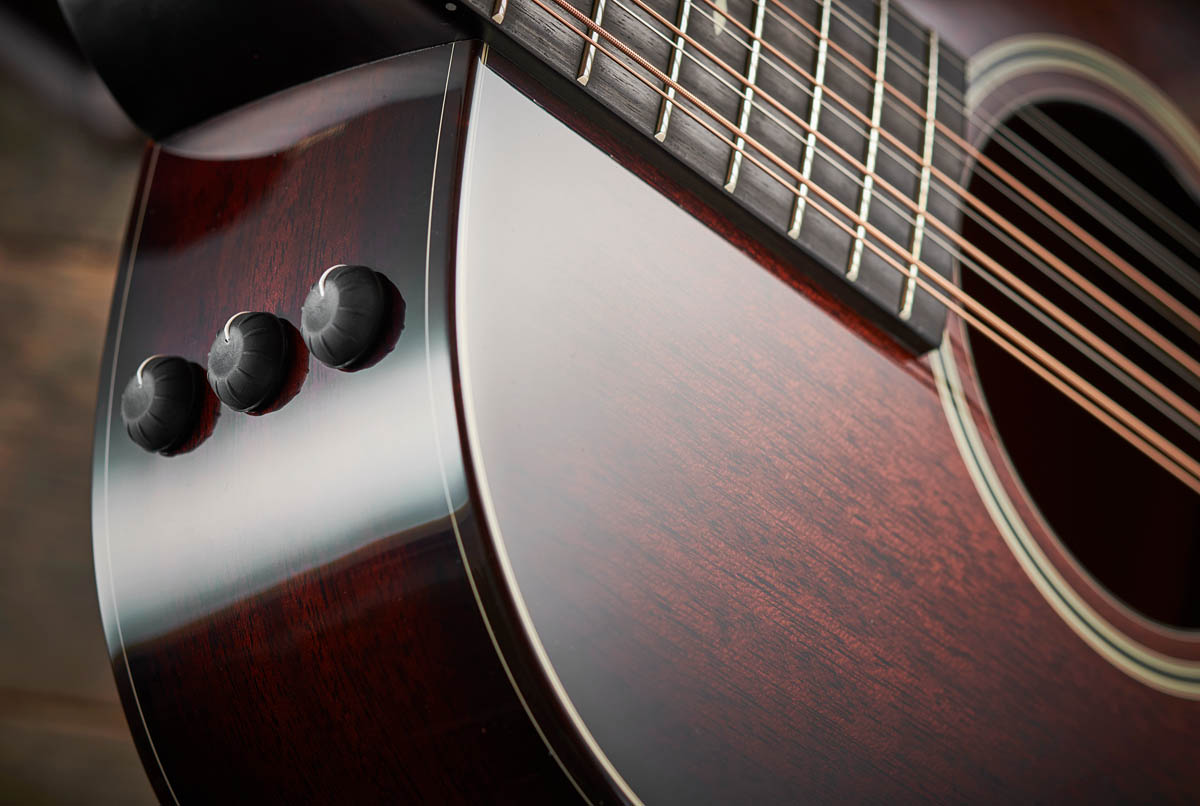
Taylor’s Expression System 2 is onboard to ensure your 12-string fantasies are ably delivered to the audience
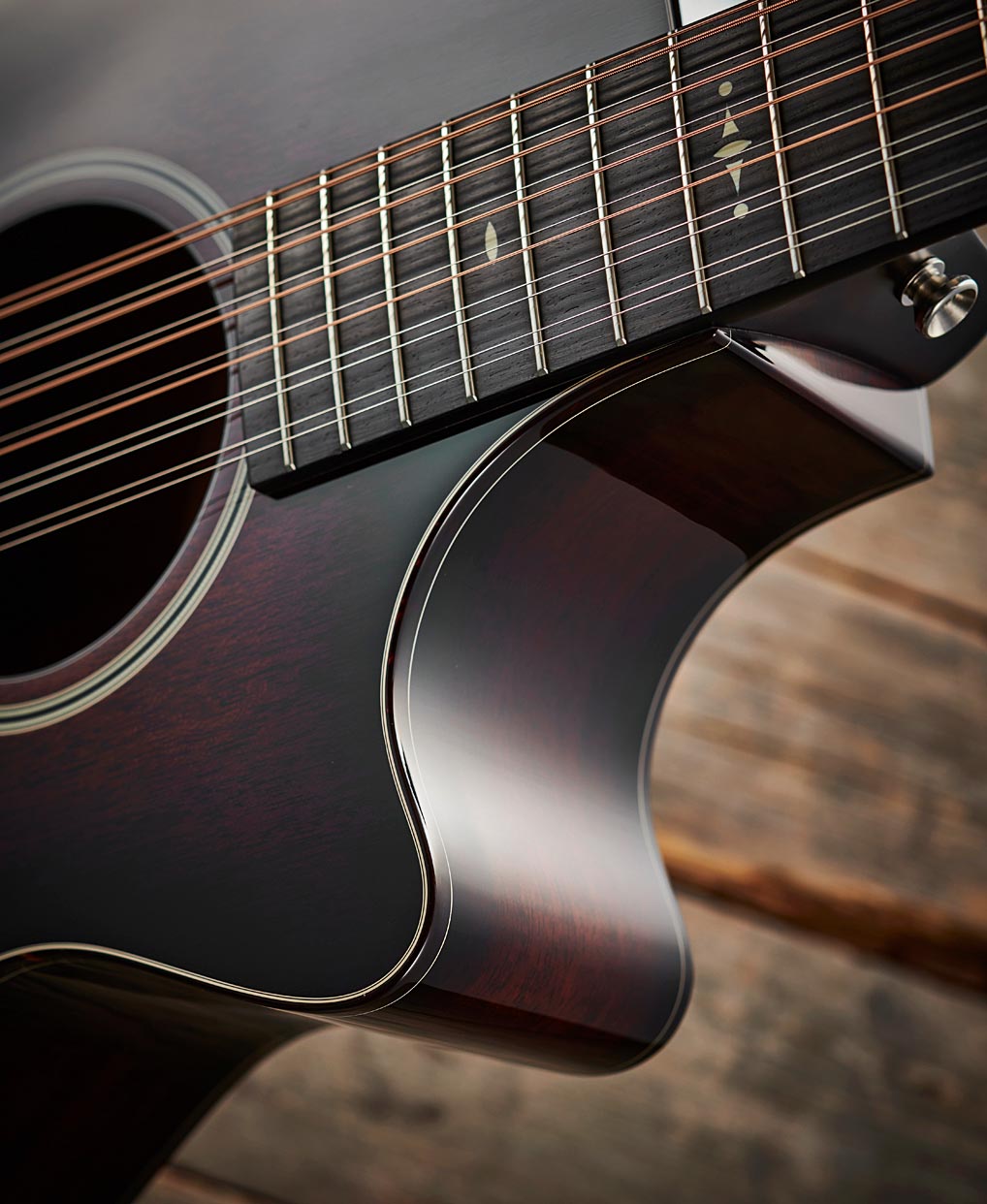
The sleek Venetian cutaway allows unfettered access to the guitar’s upper frets, should you wish to venture there
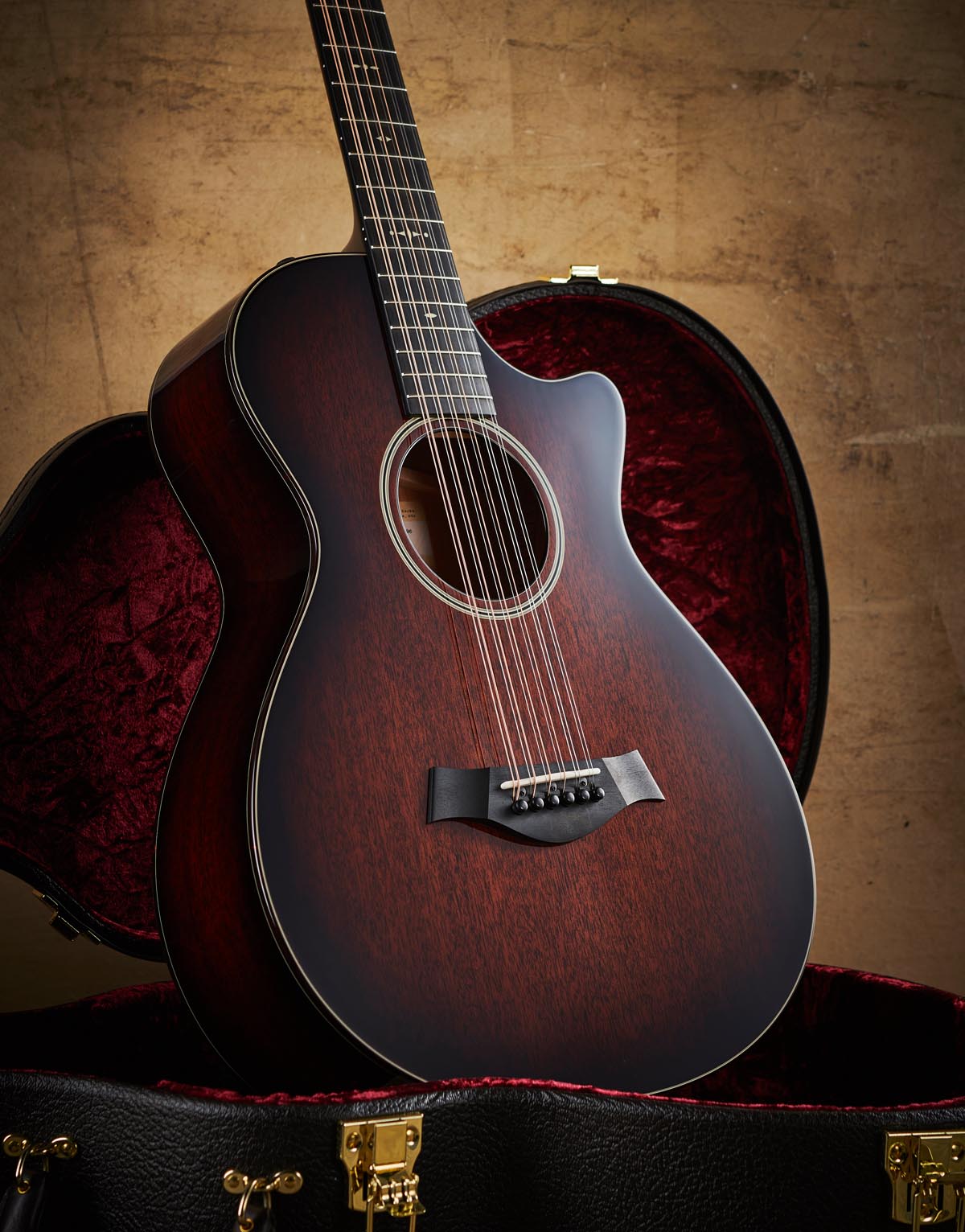
Taylor’s V-Class bracing system is sweeping through its acoustic range and the latest instrument to receive it is this Grand Concert 12-string
Feel and sounds
In order to put the claim about tuning stability fully to the test, we tuned the 562ce and took it for a quick spin and then we left it to rest over a weekend. When we took it out of its case on the Monday morning it was still bang on. So that’s one box well and truly ticked.
Sitting down to play, there’s the merest hint of neck-heaviness – only to be expected because of the combined weight of the 12 tuners and the elongated headstock – but nothing that affects the guitar’s aforementioned cuddle factor. The neck is wide but not at all ungainly, the action is low and so everything here bodes well before we’ve even taken an exploratory strum.
There is a great deal of clarity to be found here without any untoward mushiness that some 12 strings possess
When we do, we’re met with a fresh, shimmery response. There’s certainly definition in the treble and not a trace of boominess in the bass. Andy promised that instead of that slightly chorused blur that we’re used to on many 12-strings, we’d be greeted with the sound of 12 individual strings ringing together – and he was right.
It takes a little while to get used to the clarity, but once your ears have settled in a little to the sound, we found that we were enjoying the experience enormously. Through an amp (in this case one of the new Yamaha THRs on ‘Acoustic’ mode), it’s a case of any colour you like, tonally speaking, as the treble, bass and volume controls are fully capable of conjuring up any tonal landscape you require.
Verdict
The appliance of science has certainly worked with Taylor’s 562ce. There is a great deal of clarity to be found here without any untoward mushiness that some 12-strings possess and it really is a nice, compact and airy playing experience.
The only fly in the ointment is the price. At £3.3k it’s a large wedge of cash, even with all the innovations and Taylor’s renowned high-spec build-quality in place. It could prove to be deal-breaker for some players whose 12-string needs are, perhaps, just one or two numbers a night.
But if you’re after a professional instrument that offers a new wave of clarity and, more importantly, in-tuneness, then you’ll definitely find what you’re looking for here.
Specs
- PRICE: $2,999, £3,378 (inc case)
- ORIGIN: USA
- TYPE: Grand Concert 12-string cutaway acoustic
- TOP: Mahogany
- BACK/SIDES: Mahogany
- MAX RIM DEPTH: 111mm
- MAX BODY WIDTH: 381mm
- NECK: Mahogany
- SCALE LENGTH: 632mm (24.8”)
- TUNERS: Taylor nickel
- NUT/WIDTH: Tusq/47.6mm
- FINGERBOARD: Ebony
- FRETS: 18
- BRIDGE/SPACING: Ebony w/ Micarta saddle/70mm
- ELECTRICS: Taylor Expression System 2
- WEIGHT (kg/lb): 1.7/3.7
- OPTIONS: Taylor gold-plated tuners, pickguard (black, clear or tortoise), 3-piece back – all at no additional cost. Sitka spruce top, Tobacco or Honey Sunburst finishes, short-scale neck, Gotoh tuners, all at additional cost (see website for price list)
- RANGE OPTIONS: Taylor's K22e, 712ce, 312ce, 512ce and 612ce are available in the 12-Fret V-Class series.
- LEFT-HANDERS: Yes, at no extra cost
- FINISHES: Gloss Brown Edge Burst
- Taylor Guitars
With over 30 years’ experience writing for guitar magazines, including at one time occupying the role of editor for Guitarist and Guitar Techniques, David is also the best-selling author of a number of guitar books for Sanctuary Publishing, Music Sales, Mel Bay and Hal Leonard. As a player he has performed with blues sax legend Dick Heckstall-Smith, played rock ’n’ roll in Marty Wilde’s band, duetted with Martin Taylor and taken part in charity gigs backing Gary Moore, Bernie Marsden and Robbie McIntosh, among others. An avid composer of acoustic guitar instrumentals, he has released two acclaimed albums, Nocturnal and Arboretum.
The heaviest acoustic guitar ever made? Two budding builders craft an acoustic entirely from concrete because they “thought the idea was really funny”
“For years, the only 12-string acoustics I got my hands on, the necks always pulled off after a bit. I earned a lot of money replacing them!” Why one of the UK’s most prolific luthiers is a bolt-on acoustic die-hard
